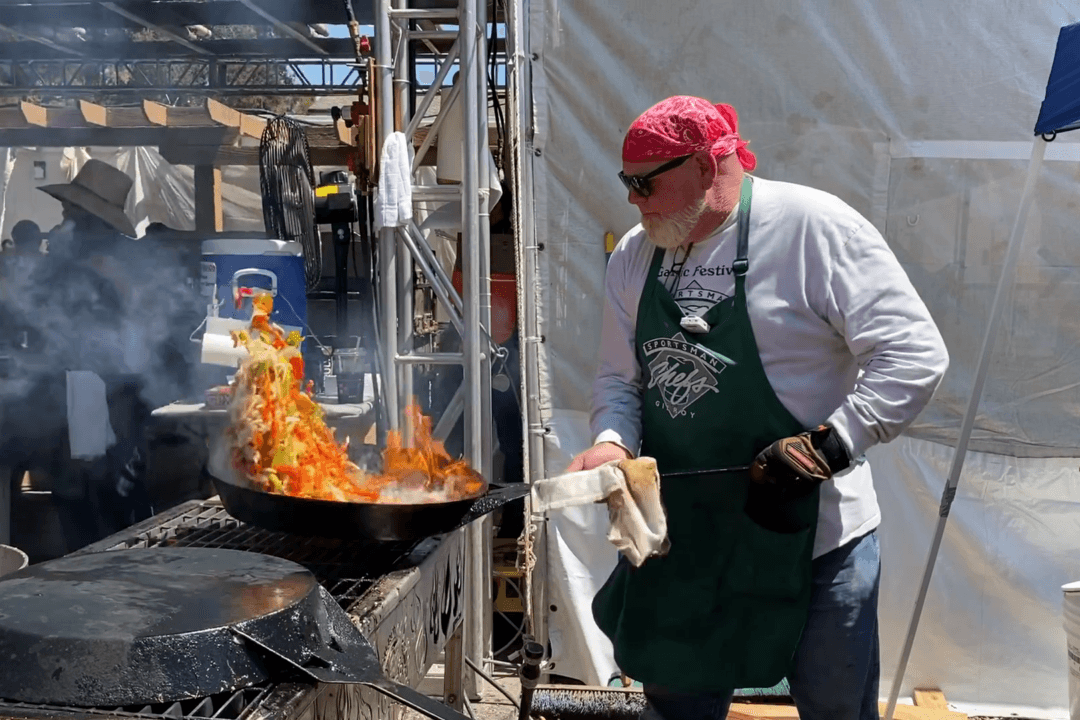“I get a focus up there like I’ve never had before,” Yager, who has been climbing for 53 years, said. “So you kind of get three benefits from it.
“One is peace and quiet and a little tranquility, and it puts you in a really good head space, especially from the hustle and bustle of working or in the city. And then you’ve got this exercise, just fantastic exercise that’s kind of a combination of pushing and pulling and exercise and stretching.
“And then the third component would be problem solving. In other words, you’ve got to be a bit of an engineer up there and figure out how to climb the thing. So you’re kind of dealing with all three things simultaneously, which makes it really unique.”
Yager became aware of climbing when he lived in southern France at 12 years old. He lived with his grandmother in Aix-en-Provence, where he attended sixth grade. One day, they rode a boat by Cassis on the Mediterranean and saw people rock climbing on the cliffs with ropes.
“I had no idea you could do any of that stuff. I immediately fell in love with it, was enthralled, and wanted to try it,” he said. “In 1971, during the summer, when I got back home from France, I had the opportunity to try climbing with the UC Davis professors and loved it right away. And from then on, I climbed every chance I could.”
Yager first tried to climb El Capitan as a teenager. After a failed attempt, he succeeded when he was 18 years old.
“I first tried it in December of 1976, about 10 days after I moved up there, and failed miserably—almost could have died—and realized that I needed to do a little more work and some overnight climbs first, which I did, and then I climbed it four times later on that year in 1977,” Yager said.
He said climbers on El Capitan generally start out slow because of all the food and water they carry, but later they get lighter and move faster. It takes about two to three days to climb the enormous rock.
“There’s about 120 different ways to climb El Capitan. Some are extremely hard, and they might take you two weeks to climb them because of the difficulty. Most people do the easier routes, and quite often [on] the easier routes they follow pretty obvious crack systems and they also have little ledge systems,” Yager said. “Some of the routes you can sleep on the ledges. If you don’t have those, other options would be to bring a portaledge, which is a hanging cot, and you just hang it off the wall, and it’s actually quite comfortable. So you can sleep on those, but they’re heavy.”
He said he is still afraid of heights, but he deals with it by understanding his equipment.
“I’ve been climbing long enough I can evaluate the rock quality, and so I feel pretty safe because I’m doing everything,” Yager said.
“It’s like driving a car. The first time you try to do it, it’s terrifying, right? And it feels very dangerous, and it probably is.
“It’s a lot like that, but as you get more and more experience, you probably become a better driver and feel a little safer, to the point where you’re comfortable with it. So climbing is kind of similar.”
Climbing El Capitan for the first time was one of Yager’s most fulfilling climbs, although he also enjoys being the first to climb a certain route.
“It was quite exciting because it was dangerous and we didn’t have, probably, enough gear, and so you could take huge falls on it,” Yager said.
“I had knee surgery earlier in the year, and so I couldn’t hardly bend my left knee, but the route went up and right diagonally, so I just kind of drug my left leg up that thing the whole way. ... I would feel lucky that I made it, but it ended up being very difficult, very scary.
“I had screws in my knee and a swollen knee, but I don’t know, for some reason I felt like I had to do it. I did it with two other people.”
After climbing for so many years, Yager said he can judge whether a rock is strong enough to use. He says he can tell by looking at it to see if there are cracks or fractures.
“But if you’re suspicious, you can tap on it. If it’s got a hollow sound to it ... if it actually vibrates, then it’s really dangerous. So there’s all different kinds of sounds you’ll get from the rock,” he said.
“Granite’s really strong; sandstone’s a little less so. And then there’s volcanic rocks that are actually kind of weak. So there’s different qualities of rock as well. So depending on the climbing area, too, there’s going to be different judgment calls.”

“I was getting tired of stepping through all this toilet paper,” he recalled. “I just decided to do something about it, and I got some raffle prizes and litter sticks I borrowed [and] bags and safety vests, and I just decided to get all the climbers in Camp Four to see if they wanted to help me clean up the park. And we spent three days doing it, and it was so much fun.”

The next year, he opened the invitation to anyone who was interested, including children on field trips. Since then, they have removed up to 16,000 pounds of trash a year.
He makes the five-day cleanup a fun and attractive event by hosting daily drawings. A volunteer needs to pick up trash to get a ticket to enter the drawing. Yager said there are now as many as 600 people participating, with more than 100 prizes. In the evenings, there are programs with some of the world’s best climbers.
“What I really like about it is this energy that builds up as it goes; everybody’s feeling really good about cleaning the park. ... There’s a lot of animosity and kind of a split country right now, but this event seems to bring everybody together,” Yager said.
The effort has expanded to other projects, such as trail maintenance and non-indigenous plant removal.

Yager said climbers and the National Park Service did not get along for years because of riots in the 1970s known as the Stoneman Meadow Riots. Thousands of visitors swarmed the park during a Fourth of July weekend. They disobeyed the park’s curfew for quiet hours and hosted loud, drunken parties through the night. Tensions between young campers and park employees turned violent.
“We looked like the hippies; that kind of scared the law enforcement, and they started carrying guns,” he recalled. “And so we weren’t treated that well.”
But Yager said he felt like climbers were part of Yosemite’s history, so he tried to push for establishing a climbing museum through a letter-writing campaign.
“Well, it pretty much got ignored until I started doing the Facelift,” he said. “All of a sudden, I went from ‘bad climber’ to like ‘a good guy, because he’s taking care of the park.’ So that really helped.
“But it took 30 years to get that approval, and two years ago, I finally got an exhibit, a permanent exhibit, in there, and it’s really popular, as I knew it would [be].”
The Yosemite Climbing Museum now has more than 10,000 items that Yager has collected over the years, with artifacts from 1875 to the modern day.
“[The] first artifact I have in the display is the 1875 spike from George Anderson, put in on the first ascent of Half Dome when he did the cables route,” Yager said. “I have one of the original spikes.”

Yager has a roster of 21 people who were in the very first climbing trip in Yosemite, called the Sierra Club climbers, during Labor Day weekend in 1933. He has some of their equipment and has met some of the climbers.
After that, he collected gear from many climbers, equipment from a first ascent in the 1960s, letters, interviews, and photos to document climbers’ stories.
“There’s a famous picture, the most famous picture: three guys standing in front of El Cap in wild colorful shirts. I have one of the shirts there, and it’s really colorful,” he said.
He has the shoes that Lynn Hill used when she free-climbed El Capitan without any gear.
“Lot of men had tried it. She was the first one to do it, and it was huge news. She’s only [5 feet, 1 inch tall]. Came in her shoes,” he said. “So I did some filming for her up there.”
Yager was also involved in preserving Yosemite’s peregrine falcons. The park found out that it had the birds in the late 1970s, so it started a program to monitor them.
Peregrine falcons fed off migratory birds from Mexico, which had traces of DDT, an insecticide. Their food source affected their eggshells, making it hard for the eggs to hatch in the wild. That’s when Yager and other climbers got involved.
“Because these birds are up on El Capitan, they needed climbers,” he said. “We went up and took a baby that was hatched in the laboratory and switched it out with an egg in a nest, with Mom and Pop dive-bombing us the whole time, trying to scare us off at a couple hundred miles an hour.
“However fast they fly is terrifying, because you’re attached to the wall and there’s no way to get out of the way. But they’re just trying to scare you. ... They flare out right by your neck.”
The climbers take the egg from the nest and put it in a little box with foam to protect it. They reach into a backpack, take out the little bird that was hatched in the lab, and put it into the nest. The parents immediately start feeding the baby bird, Yager said.
“And last I heard, they have 17 nesting pairs in Yosemite now,” he said. “So they went from one nesting pair and being almost extinct, or at least endangered, to 17 pairs, and they’re thriving now.
“They have closures on the rocks where we’re not allowed to climb near them, to allow them to lay their eggs and hatch their young. And then once they’re hatched, then we’re allowed to climb near.”
Yager said his greatest wish is to encourage climbing for those who have the chance to pursue it. With costs increasing and park access getting difficult, he tries to figure out how to keep climbing open for the younger generation.







